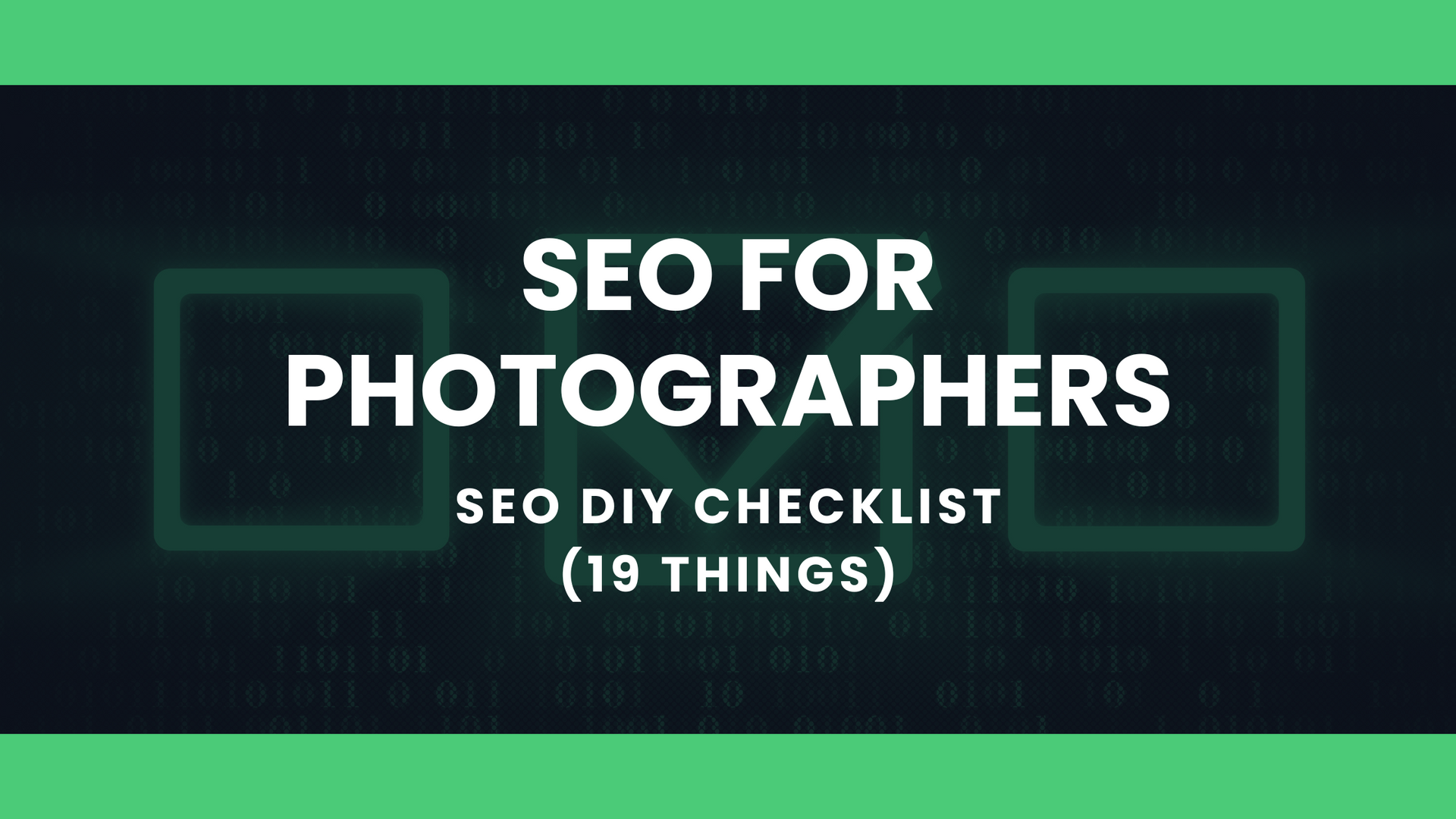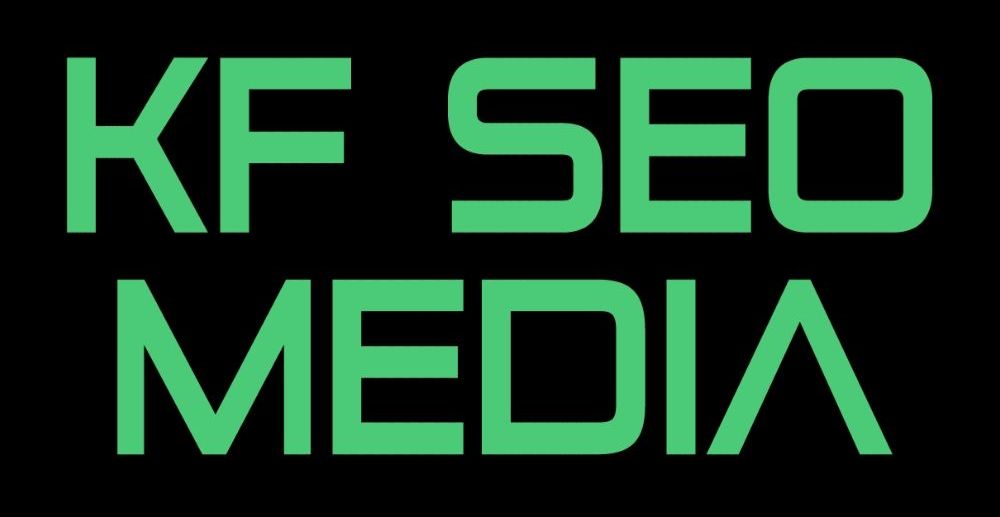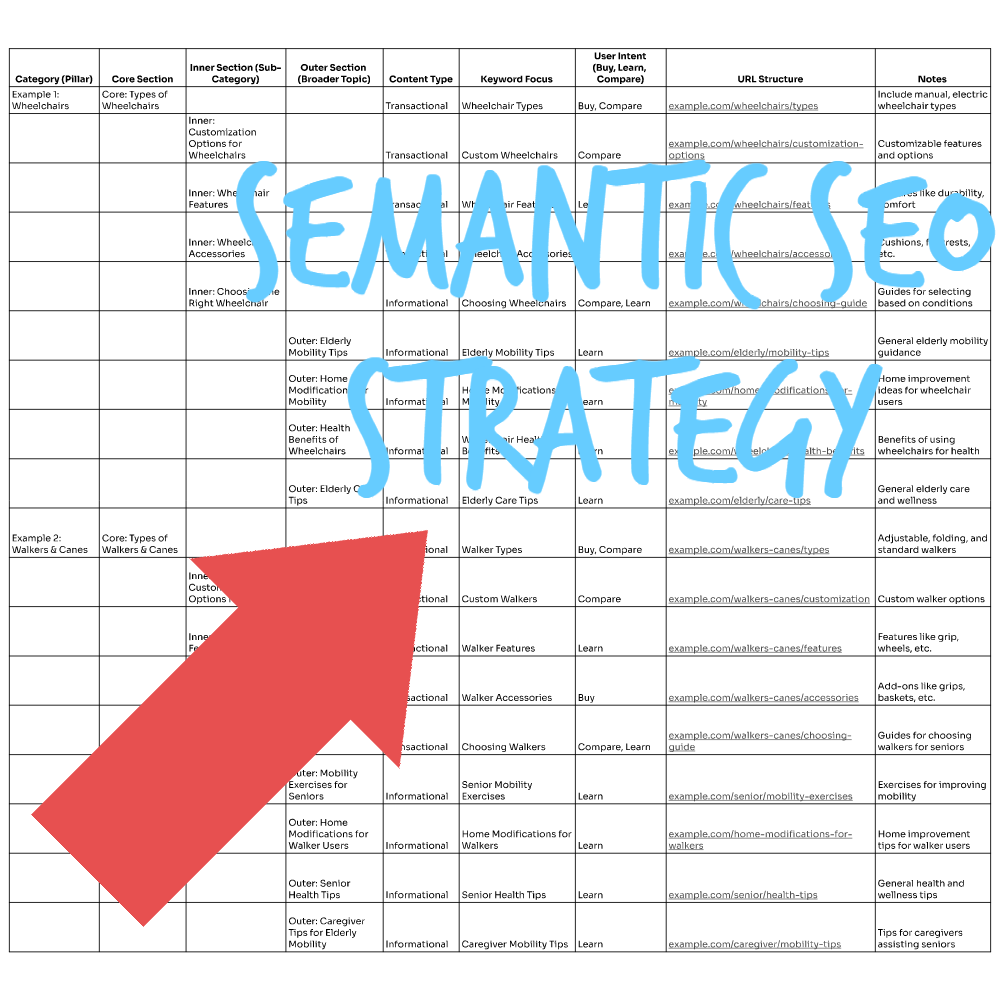
Today we are going over creating a semantic SEO topical map and its strategy.
Semantic SEO is an advanced content strategy that focuses on understanding user search intent and creating intentional content that fulfills those needs .
It’s no longer just about keywords; instead, it’s about structuring your site around a central entity (the site’s main purpose), with core pillar pages (main topics), supporting inner sections (detailed, related topics), and broader outer sections (informational topics) to fully cover user interest and search intent.
By leveraging semantic SEO, you build topical authority and relevance in the eyes of search engines, ensuring your site ranks higher and attracts the right audience.
This guide will walk you through a structured approach to creating a successful semantic SEO strategy, complete with detailed examples.
Let’s explore what makes an effective semantic SEO topical map and how you can build one to improve your overall SEO.
Remember, the goal of semantic SEO is to align your content with user needs while improving your site’s authority and search engine visibility.
Defining Your Central Entity for SEO Success
The central entity is the core product, service, or topic around which your entire website's content will revolve. The central entity is the foundation around which every other idea is built.
For example, if your business is focused on selling mobility aids, 'wheelchairs' may be your central entity. This central entity will guide how you structure your content strategy, with core, inner, and outer sections expanding on it to address both user needs and search intent.
We’ll discuss this below by outlining all the components of creating topical authority with Semantic SEO.
Best Practices for Defining Your Central Entity:
- Keep your central entity focused on a single product, service, or topic.
- Ensure all content revolves around this entity to build authority.
- Avoid broad or unrelated entities to prevent diluting your site's focus.
Key Components of a Semantic SEO Strategy
Central Entity
- Focus : "Wheelchairs" (or broaden to "aids for elderly people").
- Appearance : Included in both the core and outer sections of your topical map.
Central Search Intent
- Primary Objective : Combine the context of selling aids (e.g., wheelchairs) with the users' search intent.
- Targeted Intent : Focus on actions like "buy," "learn," and "compare" wheelchairs, addressing both transactional and informational needs.
Source Context
- Main Action : Buying wheelchairs.
- Secondary Actions :
- Learning about different types of wheelchairs.
- Comparing wheelchairs before making a purchase.
- Answering informational queries about product features and benefits.
Core Section (Primary Focus)
- Topics to Cover :
- Types of wheelchairs (e.g., manual, electric).
- Features (e.g., durability, comfort, ease of use).
- Price ranges.
- Customization options.
- Health benefits for specific conditions (e.g., paralysis, mobility issues).
- Goal : Target the main keyword ("wheelchairs") and related transactional intents.
Outer Section (Supplementary Focus)
- Additional Topics :
- Elderly care tips.
- Wheelchair accessories (e.g., cushions, footrests).
- Guides on choosing the right wheelchair based on health conditions.
- General elderly health and mobility topics.
- Goal : Support the core section by driving extra traffic and reinforcing topical authority.
Pillar/Root Pages
- Structure : Create pillar pages for 4 priority categories, such as "wheelchairs."
- These pages should provide deep dives into topics like types of wheelchairs and wheelchair buying guides.
- Content Focus :
- Replace traditional blog posts with resource pages, such as product guides and comparison pages.
- Structure URLs like website.com/wheelchairs/article to maintain focus on the products and enhance topical relevance.
Example 1: Semantic SEO Site Map Structure
Entity: Aids for Elderly People
This Aids for Elderly People example provides a detailed illustration of how to create a semantic SEO topical map, breaking down core, inner, and outer sections. Below is a table that summarizes the structure, followed by a visual site map to demonstrate how it could look in URLs.
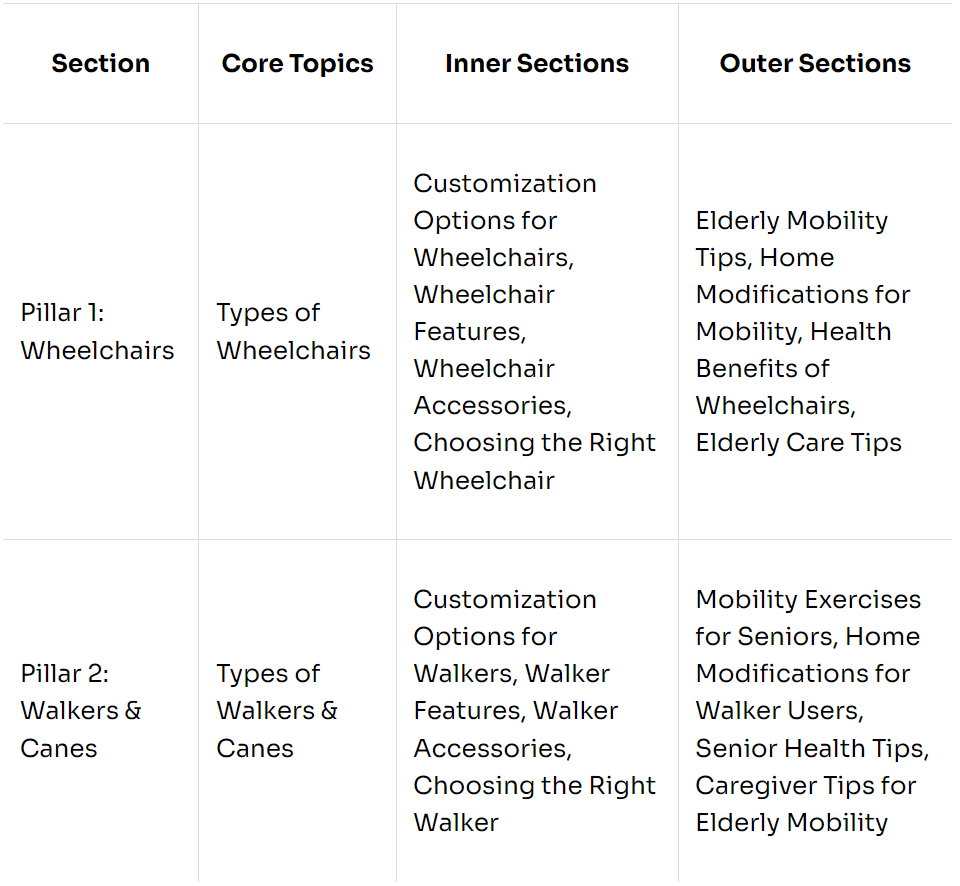
Aids for Elderly People Site Map Structure
Homepage
- example.com
Pillar 1: Wheelchairs
- example.com/wheelchairs
Core : Types of Wheelchairs
- example.com/wheelchairs/types
Inner Sections :
- Customization Options for Wheelchairs
- example.com/wheelchairs/customization-options
- Wheelchair Features
- example.com/wheelchairs/features
- Wheelchair Accessories
- example.com/wheelchairs/accessories
- Choosing the Right Wheelchair
- example.com/wheelchairs/choosing-guide
Outer Sections (Broader Topics) :
- Elderly Mobility Tips
- example.com/elderly/mobility-tips
- Home Modifications for Mobility
- example.com/home-modifications-for-mobility
- Health Benefits of Wheelchairs
- example.com/wheelchairs/health-benefits
- Elderly Care Tips
- example.com/elderly/care-tips
Pillar 2: Walkers & Canes
- example.com/walkers-canes
Core : Types of Walkers & Canes
- example.com/walkers-canes/types
Inner Sections :
- Customization Options for Walkers
- example.com/walkers-canes/customization
- Walker Features
- example.com/walkers-canes/features
- Walker Accessories
- example.com/walkers-canes/accessories
- Choosing the Right Walker
- example.com/walkers-canes/choosing-guide
Outer Sections (Broader Topics) :
- Mobility Exercises for Seniors
- example.com/senior/mobility-exercises
- Home Modifications for Walker Users
- example.com/home-modifications-for-walkers
- Senior Health Tips
- example.com/senior/health-tips
- Caregiver Tips for Elderly Mobility
- example.com/caregiver/mobility-tips
Summary of the Site Map Structure:
- The core sections cover the primary product pages related to wheelchairs and walkers & canes , focusing on their types and features.
- The inner sections provide additional detailed content, like customization, accessories, and choosing guides.
- The outer sections focus on broader informational topics, such as mobility tips and elderly care, which add authority and drive further traffic to the website.
Example 2: Semantic SEO Site Map Structure
Entity: Ice Cream
This ice cream example provides a second illustration of how to create a semantic SEO topical map, breaking down core, inner, and outer sections. Below is a table that summarizes the structure, followed by a visual site map to demonstrate how it could look in URLs.
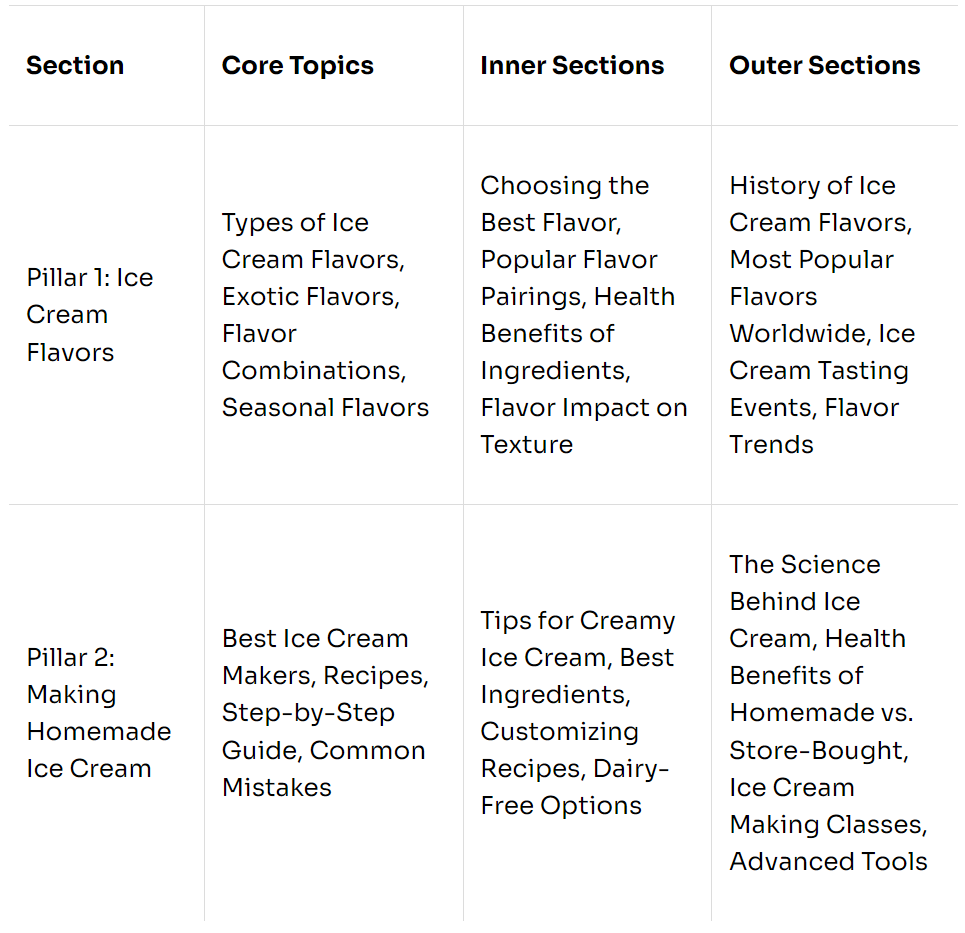
Ice Cream Site Map Structure
Homepage
- example.com
Pillar 1: Ice Cream Flavors
- example.com/ice-cream/flavors
Core : Types of Ice Cream Flavors
- example.com/ice-cream/flavors/types
Inner Sections :
- Customization Options for Ice Cream
- example.com/ice-cream/flavors/customization-options
- Flavor Combinations
- example.com/ice-cream/flavors/combinations
- Health Benefits of Ice Cream Ingredients
- example.com/ice-cream/flavors/health-benefits
- Choosing the Right Ice Cream Flavor
- example.com/ice-cream/flavors/choosing-guide
Outer Sections (Broader Topics) :
- History of Ice Cream Flavors
- example.com/ice-cream/flavors/history
- Most Popular Ice Cream Flavors Worldwide
- example.com/ice-cream/flavors/worldwide
- Ice Cream Tasting Events
- example.com/ice-cream/tasting-events
- Flavor Trends in the Ice Cream Industry
- example.com/ice-cream/flavor-trends
Pillar 2: Making Homemade Ice Cream
- example.com/ice-cream/homemade
Core : Best Ice Cream Makers
- example.com/ice-cream/homemade/makers
Inner Sections :
- Homemade Ice Cream Recipes
- example.com/ice-cream/homemade/recipes
- Tips for Achieving Creamy Ice Cream
- example.com/ice-cream/homemade/creamy
- Best Ingredients for Homemade Ice Cream
- example.com/ice-cream/homemade/ingredients
- Customizing Homemade Ice Cream Recipes
- example.com/ice-cream/homemade/customization
Outer Sections (Broader Topics) :
- The Science Behind Making Ice Cream
- example.com/ice-cream/science
- Health Benefits of Homemade vs. Store-Bought Ice Cream
- example.com/ice-cream/homemade-vs-store
- Ice Cream Making Classes and Workshops
- example.com/ice-cream/classes
- Equipment for Advanced Ice Cream Makers
- example.com/ice-cream/equipment
Creating Pillar Topics For the Central Entity
Base Pillar Topics on Audience Search Intent
Before you build these pillar pages, have a firm understanding of your website’s overall purpose and central entity. Once you’ve identified the central entity, your pillar topics should be based on the search intent of your audience. Search intent refers to the purpose behind a user’s search—whether they’re looking to buy a product, compare options, or gather information.
Content should be tailored to address both immediate needs (buying guides, comparisons) and informational queries (how-tos, tips).
For example, if your audience is looking to buy wheelchairs , you’d create a pillar page that provides a comprehensive guide to wheelchair types, features, and prices. If they’re in the research phase, you might create content around how to choose the right wheelchair for specific needs.
Step : Identify the different search intents your audience may have by using these three terms:
- Buying
- Learning
- Comparing
Differentiate and create pillar content that meets these needs.
Best Practices for Aligning Content with Search Intent:
- Use keyword research tools to identify intent behind each query (buy, learn, compare).
- Create content that satisfies different stages of the user journey.
- Ensure every piece of content answers the specific needs of your audience.
What to Consider Before Creating Pillars
Another thing before building pillar pages, think of all of the supporting topics that will reinforce your core pages. These supporting topics will act as inner sections , expanding on the details of your pillars. For example, once you have a pillar page on wheelchair types, you’ll need inner content on specific wheelchair features, customization options, or accessories.
Without these supporting topics, your pillars will lack the depth needed to build topical authority and rank well in search results.
Step : Outline all related topics (e.g., customization, features, accessories) that will provide depth to your pillar content. These supporting topics will help you create a more comprehensive structure.
Constructing Your Pillar and Root Pages for SEO Authority
After understanding your central entity and search intent, you can now create pillar/root pages . These pages are the core of your content structure and should offer comprehensive coverage of the main topics tied to your central entity.
Start with defining the core sections that directly relate to your central product or service, such as detailed content on wheelchair types or features.
Step : Build root pages that align with your main service or product categories, such as a guide to types of wheelchairs or a page focused on their health benefits. Ensure these root pages directly address your audience’s transactional or informational needs.
Best Practices for Building Pillar Pages:
- Ensure pillar pages cover the core topic comprehensively.
- Include internal links to inner and outer sections to create a robust content structure.
- Target long-tail keywords and provide in-depth answers to key questions.
Pillar Pages Key Points
In summary, your semantic SEO strategy should follow these clear steps:
1. Identify the central entity of your website and define your main product or service.
2. Create pillar pages based on audience search intent—whether they are looking to buy, compare, or learn.
3. Build root pages that align with your business’s core topics, and ensure you have supporting content for each.
4. Understand audience needs by focusing on their search intent and creating content that guides them through their journey.
These steps will help ensure your content is structured for both clarity and authority, aligning perfectly with the audience’s needs.
Example of Pillar Pages with Supporting Content
1. Central Entity: Wheelchairs
- Main product: Wheelchairs
- Search intents: Buying, comparing, learning
- Audience needs: Transactional (buying), informational (learning)
2. Pillar Pages (Root Content)
These are the core pages that target the primary search intents . Each pillar page provides comprehensive information about a key aspect of the central entity (wheelchairs):
1. Types of Wheelchairs
· URL: example.com/wheelchairs/types
· Content: Overview of manual, electric, and sports wheelchairs.
· Search intent: Learn and Compare
5. Wheelchair Buying Guide
· URL: example.com/wheelchairs/buying-guide
· Content: Step-by-step guide to choosing a wheelchair.
· Search intent: Buy
9. Wheelchair Features
· URL: example.com/wheelchairs/features
· Content: Details on important features like durability, comfort, ease of use.
· Search intent: Compare
3. Supporting (Inner) Sections
These sections provide in-depth content that supports the pillar pages. They expand on specific details and help guide the user further in their decision-making process.
1. Wheelchair Customization Options
· URL: example.com/wheelchairs/customization
· Content: Customization features (e.g., adjustable seats, footrests).
· Related to: Wheelchair Features page.
· Search intent: Learn and Compare
2. Wheelchair Accessories
· URL: example.com/wheelchairs/accessories
· Content: Popular accessories like cushions and footrests.
· Related to: Types of Wheelchairs and Features pages.
· Search intent: Buy
4. Broader (Outer) Sections
These topics are broader, informational content that support your topical authority and attract traffic. They are related to the niche but not directly tied to buying.
1. Elderly Mobility Tips
· URL: example.com/elderly/mobility-tips
· Content: General advice on mobility for aging individuals.
· Search intent: Learn
2. Home Modifications for Wheelchair Users
· URL: example.com/home-modifications-for-mobility
· Content: Ideas for making homes more wheelchair-friendly.
· Search intent: Learn
Complete Structure at a Glance:
Pillar Pages :
· Types of Wheelchairs
· Wheelchair Buying Guide
· Wheelchair Features
Supporting Pages (Inner Sections) :
· Customization Options
· Wheelchair Accessories
Broader Topics (Outer Sections) :
· Elderly Mobility Tips
· Home Modifications for Wheelchair Users
Step-by-Step Guide to Creating a Semantic SEO Topical Map
1. Identify Your Central Entity
· Start by pinpointing the main product, service, or topic your website focuses on. This is your central entity. For example, if your website sells mobility aids, "wheelchairs" might be your central entity.
· Define the overarching theme or purpose that encompasses all your content efforts.
2. Determine Core User Intent
· Analyze and list the primary user intents associated with your central entity. Typical intents include "buy," "learn," and "compare."
· This understanding will direct the structure of your content to meet specific user needs effectively.
3. Map Out Core Content (Pillar Pages)
· Create pillar pages that comprehensively cover the central entity. For "wheelchairs," core content might include detailed guides on different types of wheelchairs, their features, and usage benefits.
· Ensure each pillar page targets primary transactional keywords related to purchasing or comparing options.
4. Outline Inner Sections
· Develop inner sections that offer more specific, in-depth information linked to your pillar content. Examples include customization options for wheelchairs, in-depth features, and comparisons of different models.
· Each inner section should focus on enhancing the core content, often targeting "compare" or "learn" intents.
5. Expand with Outer Sections
· Add broader topics that are relevant but not directly linked to the central entity. For a wheelchair-focused site, this might include general mobility tips, elderly care advice, or home modifications for accessibility.
· These sections help build your site’s topical authority and cater to broader informational needs.
6. Assign Keywords and Define Content Type
· For each section (pillar, inner, outer), assign specific keywords that best represent the user intent and search volume. This will optimize your content for search engines and ensure it meets user queries effectively.
· Label each piece of content by type—informational, transactional, or comparison—to align with user intent.
7. Plan URL Structure
· Design SEO-friendly URLs for each page that are simple, descriptive, and aligned with the content’s keyword focus. For example, example.com/wheelchairs/customization-options for a page on wheelchair customization.
8. Develop Content and Interlink Pages
· Create content that addresses the defined user intents, ensuring it is rich in information and easy to navigate.
· Strategically interlink between core, inner, and outer pages to facilitate user journey and enhance SEO by showing content relevancy and depth.
9. Continuously Optimize and Update
· Regularly review and update your content to reflect new insights, user feedback, and changes in user behavior or search engine algorithms.
· Add new sections or topics as needed to maintain topical authority and relevance.
Understanding and Structuring Core, Inner, and Outer Sections
Core Section
The core section is the foundation of your site’s content and topical map. It focuses directly on your central entity and covers the most important topics related to that entity. These topics address primary intents , which usually have commercial or transactional goals (e.g., buying or selecting a product).
Example : If your central entity is "wheelchairs," your core section will focus on:
- Types of wheelchairs (manual, electric)
- Key features (durability, comfort, ease of use)
- Health benefits of wheelchairs for people with mobility issues
- Price ranges or buying guides
In this section, your content is closely tied to your main product or service. The goal here is to capture users who are actively looking to purchase or compare products, satisfying transactional intent .
Inner Section
The inner section includes additional but closely related content that expands on the core section topics. These can also be informational but still support the product or service, offering more depth.
Example for wheelchairs :
- Customization options for wheelchairs
- Accessories for wheelchairs (e.g., cushions, footrests)
- Guides to choosing the right wheelchair for different health conditions
These topics supplement the core content, and while not directly transactional, they guide users toward purchasing decisions . The inner section helps establish authority by answering deeper questions about your product or related services.
Best Practices for Creating Inner Sections:
- Use inner sections to dive into detailed features , comparisons , or guides .
- Ensure inner pages link back to pillar pages to maintain content hierarchy.
- Use relevant keywords that support the broader pillar content.
Outer Section
The outer section expands on broader or supplementary topics that may not directly relate to your product but are still relevant to the larger context of your niche. The goal here is to build topical authority and attract additional traffic by addressing a wider range of user intents , especially informational intent .
Example for wheelchairs :
- General elderly care tips
- Mobility tips for aging individuals
- Wheelchair-friendly home modifications
While these topics may not directly push users toward purchasing a wheelchair, they build topical authority and relevance for your site in the wider niche of elderly care or mobility aids.
Best Practices for Expanding with Outer Sections:
- Focus on informational content that covers related topics to attract a broader audience .
- Use these sections to build topical authority by addressing general but important areas.
- Ensure that outer sections still relate to the central entity to keep your content relevant.
Internal Linking Strategy: How to Connect Core, Inner, and Outer Sections
An effective internal linking strategy plays a crucial role in your semantic SEO approach. Internal links help guide users through your content, improving their experience, while also signaling to search engines the relationship between pages on your website. Here's how you can structure internal links between your core, inner, and outer sections:
1. Linking Core to Inner Sections
- Your pillar pages (core content) serve as the central hubs of your topical map, and they should link to all the inner section pages that dive deeper into specific aspects of the topic.
- For example, a pillar page on "Types of Wheelchairs" should internally link to supporting content like "Wheelchair Customization Options" or "Wheelchair Features." This not only helps users navigate to more specific details but also signals to search engines that these inner pages are essential subtopics of the core topic.
2. Linking Inner Sections Back to the Core
- Each inner section page should also link back to the relevant pillar page. This creates a two-way link that strengthens the relationship between the core content and its subtopics. For instance, within the "Wheelchair Features" page, you could include a call-to-action linking back to the main "Types of Wheelchairs" pillar page for users wanting a broader overview.
3. Linking Inner Sections to Each Other
- In addition to linking back to the core, cross-link inner pages where relevant. If "Wheelchair Features" and "Customization Options" are related, linking them to each other will help users find all the information they need. This creates a web of interconnected content that improves user navigation and keeps readers engaged longer on your site.
4. Linking Outer Sections to Core and Inner Pages
- Outer sections provide informational or broader topics, and they should link back to relevant pillar and inner section pages . For example, an outer page on "Elderly Mobility Tips" might link to your core "Wheelchair" pillar page, helping users interested in mobility aids navigate to more specific content. By linking outer sections to both core and inner pages, you help guide users from general information to more specific, actionable content.
5. Ensuring Seamless Navigation
- Make sure the linking is natural and user-friendly . Anchor text for internal links should be descriptive, letting users know where they will be directed. Avoid excessive linking on a single page, as this can overwhelm readers and reduce the effectiveness of your strategy.
Best Practices for Internal Linking
- Link Naturally : Ensure your links fit contextually within the content and guide users to valuable, relevant information.
- Use Descriptive Anchor Text : Anchor text should clearly describe what the linked page is about to improve user experience and SEO.
- Cross-Link Relevant Content : Build connections between related inner sections and outer sections, so users can easily explore more on the topic.
By following this internal linking strategy, you will not only enhance user navigation but also boost SEO by improving your site’s topical authority and content relevance. Search engines will better understand the hierarchy and depth of your content, rewarding you with better rankings.
How Core, Inner, and Outer Sections Correlate
- Core Section : Your central product or service and the key topics that target transactional user intent (e.g., buying, comparing, features).
- Inner Section : Expands on the core section with supporting or closely related topics that still revolve around the central product but often target informational intent .
- Outer Section : Broadens the scope, providing general or related content that indirectly supports the main topic and helps attract traffic and reinforce topical authority .
Steps for Structuring Core, Inner, and Outer Sections
- Core Section : Start by identifying the main product or service you want to rank for. Break this down into primary categories like types, features, and benefits.
- Example : "Wheelchairs" → Sub-pages: Types, Features, Price, Health Benefits.
- Inner Section : After identifying the core topics, think about supporting topics that are directly tied to the product but offer more specific or detailed information .
- Example : Customization, Accessories, Choosing the right wheelchair based on conditions.
- Outer Section : Once the core and inner content is covered, identify broader topics related to your niche. These should still be relevant but not directly focused on the product itself.
- Example : Elderly care tips, Home modifications for mobility, General health tips for people with disabilities.
Example of Pillar with Core, Inner, and Outer Sections:
Core Section :
· Wheelchairs (Main category)
· Types of wheelchairs (Manual, Electric, Sport)
· Features of wheelchairs (Durability, Comfort, Ease of Use)
· Wheelchair Buying Guide
Inner Section :
· Wheelchair Customization Options
· Wheelchair Accessories (Cushions, Footrests)
· Choosing the Right Wheelchair for Different Health Conditions
Outer Section :
· Elderly Care Tips
· Home Modifications for Mobility Needs
· Tips on Maintaining Mobility as You Age
By starting with the core section , you directly target high-converting keywords . As you build your inner section, you add depth to your core content, while the outer section helps expand your topical relevance and authority .
Example Table of a Semantic SEO Topical Map
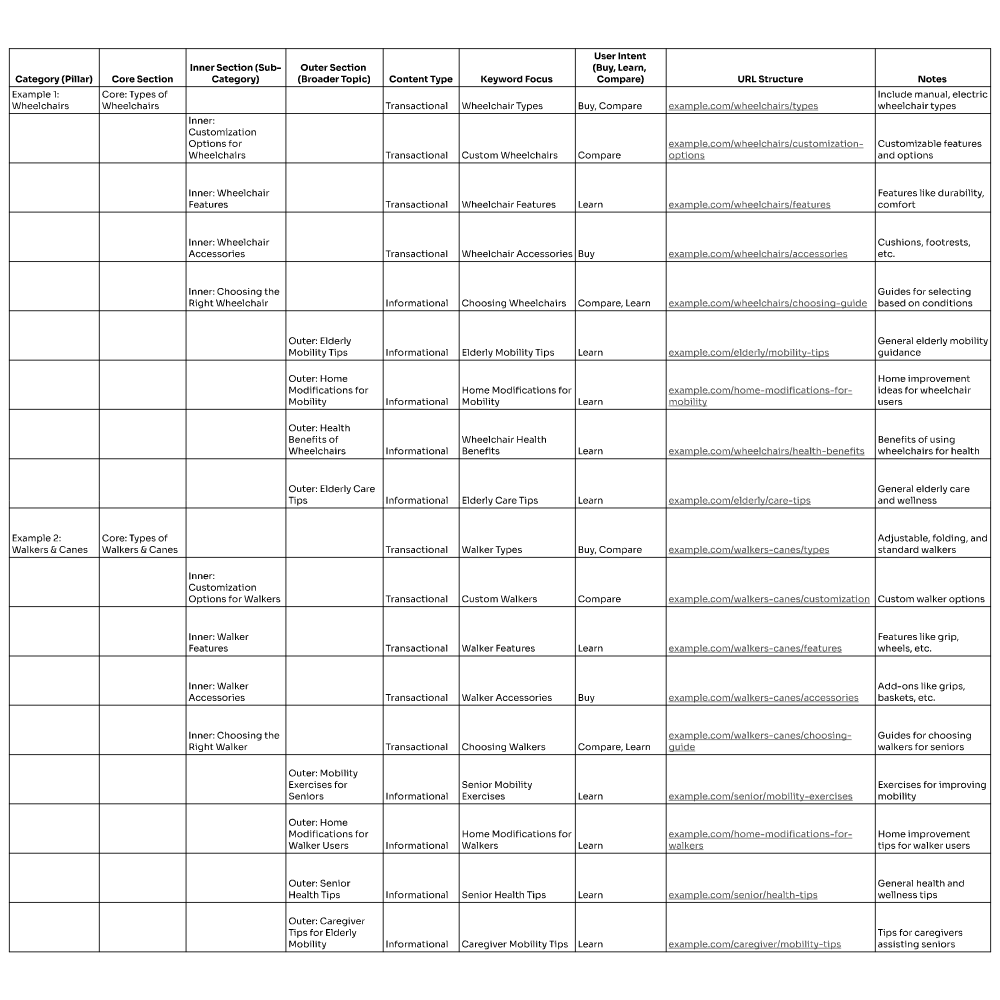
Notes on Building a Table for Semantic SEO Topical Map
1. Category (Pillar)
· This column represents the central entity of your content, like "Wheelchairs" or "Walkers & Canes." The pillar is the overarching topic around which you build the core content and all supporting sections (inner and outer).
· Each category should target the primary product or service your audience is interested in.
2. Core Section
· This column focuses on the main pillar page for each category. Core pages should be broad and comprehensive, targeting high-intent, transactional keywords. They typically answer questions related to "buy" or "compare" and provide a strong foundation for the rest of your content.
· Core pages drive the most direct user actions.
3. Inner Section (Sub-Category)
· The inner sections provide more specific and detailed information about sub-topics that support the core section. These pages dive deeper into aspects like customization, features, or accessories.
· They are designed to help users compare options and learn more about specific features, enhancing their decision-making process.
4. Outer Section (Broader Topic)
· Outer sections cover broader, informational topics related to the central entity, but not directly tied to a specific transaction. These pages help build your topical authority by covering general advice or tips (e.g., "Elderly Care Tips" or "Mobility Exercises for Seniors").
· They target informational user intent , providing value to users at the top of the funnel.
5. Content Type
· This column identifies whether each piece of content is transactional , informational , or comparison-based .
· Knowing the content type helps you align your SEO efforts with the user’s needs and optimize the page for the appropriate search intent .
6. Keyword Focus
· This column lists the primary keyword each page targets. These keywords should align with the user intent outlined earlier (buy, learn, compare).
· Ensuring your content matches the right keyword helps you rank effectively for different stages of the user journey. Focus on one primary keyword per page for maximum relevance.
7. User Intent (Buy, Learn, Compare)
· Clearly defining the user intent behind each page (whether users want to buy, learn, or compare) is crucial.
· This column ensures that every page aligns with the correct stage of the decision-making process, helping you target the user’s specific needs with the right content.
8. URL Structure
· This column outlines the SEO-friendly URL for each page. Keeping your URLs simple, descriptive, and reflective of the content ensures better indexing by search engines and improves user navigation.
· Consistency in your URL structure also helps users understand the content hierarchy on your site and enhances internal linking opportunities.
Best Practices for Optimizing URL Structure:
· Keep URLs short, descriptive, and consistent across the site.
· Use relevant keywords in the URL, but avoid keyword stuffing or excessive length.
· Maintain a clear hierarchy that reflects the content structure.
9. Notes
· The notes section provides extra context or reminders for each page. This could include details about the features or accessories covered, or additional guidance on what should be included in each piece of content.
· Use this column to add useful information that helps in content planning and development.
FAQ Section: Common Questions About Semantic SEO
What’s the difference between traditional SEO and semantic SEO?
Traditional SEO focuses on targeting specific keywords to rank individual pages. In contrast, semantic SEO focuses on understanding the intent behind user queries and creating content that addresses broader topics in a cohesive, interconnected way. This approach helps build topical authority , ensuring search engines recognize your site as an expert source on a given subject.
How do I determine the right central entity for my website?
Your central entity should represent the main product, service, or category that your website revolves around. To determine this, ask yourself: "What is the primary focus of my business?" and "What do I want my site to be known for?" For example, if your business sells mobility aids, your central entity could be "wheelchairs." All supporting content should branch off this main topic.
How often should I update my semantic SEO strategy?
It’s recommended to audit and update your semantic SEO strategy every 6-12 months . You should also refresh your content whenever there are changes in user behavior , search trends , or when your business launches new products or services . Keeping content up to date helps maintain topical authority and relevance.
How can I measure the success of my semantic SEO strategy?
You can track the success of your strategy through a combination of metrics:
- Search Rankings : Monitor keyword rankings and whether your content is moving up in search results.
- Organic Traffic : Measure how much traffic your site is gaining from search engines.
- Engagement Metrics : Track user behavior on your site, such as time spent on pages, bounce rates, and conversions.
- Conversions : Measure whether your SEO strategy is contributing to tangible results, like product sales or leads.
Tools like Google Analytics , Google Search Console , and third-party platforms like Ahrefs or SEMrush can help track these metrics.
What tools should I use for keyword research and performance tracking?
Some of the most popular tools for keyword research and performance tracking include:
- Google Search Console : For monitoring search performance and site indexing.
- Google Analytics : To track traffic, user behavior, and engagement.
- SEMrush / Ahrefs : For in-depth keyword research, competitor analysis, and backlink tracking.
- Moz : For tracking domain authority and keyword rankings.
- AnswerThePublic : To find common questions and topics related to your central entity.
How do I ensure my topical map stays relevant over time?
Keeping your topical map relevant requires regular updates. This involves:
- Tracking changes in search behavior and industry trends .
- Refreshing outdated content to reflect new information.
- Identifying new keyword opportunities to address emerging user queries. By continuously auditing and updating your content, you maintain your site’s authority and ensure your content is aligned with current user needs.
Creating a Semantic SEO Topical Map Strategy
Semantic SEO Topical Map Template Download
If you'd like a copy of the templated SEO Topical Map, download it here.
Edmonton, AB, Canada
587.405.9626
info@kfseomedia.com
